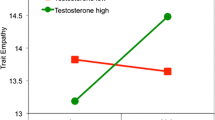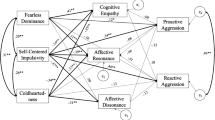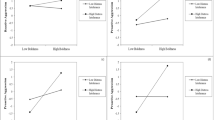Abstract
Psychopathy is thought to be related to a lack of empathy which interferes with conscience development and promotes aggressive behavior. Little research has examined underlying mechanisms contributing to psychopathy, empathy, and aggression, such as an altered Hypothalamic-Pituitary-Adrenal axis response system. The current study examined how subscales of psychopathic personality traits, empathy, and aggression are related to the cortisol awakening response (CAR), an index of an individual’s physiological preparedness for the challenges of the upcoming day. A mixed-sex sample of 57 college students was recruited for the study, and HLM analyses tested whether these constructs were related to blunted CAR. Results indicated that Machiavellian Egocentricity, Blame Externalization, and Carefree Nonplanfulness subscales of the Psychopathic Personality Inventory – Short Form were all related to blunted CAR, whereas the Social Potency subscale was significantly related to steeper CAR increase. Further, affective empathy and reactive physical aggression were related to blunted CAR. Findings suggest that CAR provides a novel biological index of psychopathic personality traits, affective empathy, and reactive physical aggression.

Similar content being viewed by others
References
Anestis, J. C., Caron, K. M., & Carbonell, J. L. (2011). Examining the impact of gender on the factor structure of the psychopathic personality inventory-revised. Assessment, 18, 340–349.
Archer, J. (2004). Sex differences in aggression in real-world settings: a meta-analytic review. Review of General Psychology, 8, 291–322.
Bartels, M., De Geus, E. J., Kirschbaum, C., Sluyter, F., & Boomsma, D. I. (2003). Heritability of daytime cortisol levels in children. Behavioral Genetics, 33, 421–33.
Batson, C. D., Fultz, J., & Schoenrade, P. A. (1987). Distress and empathy: two qualitatively distinct vicarious emotions with different motivational consequences. Journal of Personality, 55, 19–39.
Bell, B. A., Morgan, G. B., Schoeneberger, J. A., Loudermilk, B. L., Kromrey, J. D., & Ferron, J. M. (2010). Dancing the sample size limbo with mixed models: How low can you go? SAS Global Forum, paper 197.
Batson, C. D., Fultz, J., & Schoenrade, P. A. (1987). Distress and empathy: two qualitatively distinct vicarious emotions with different motivational consequences. Journal of Personality, 55, 19–39.
Benning, S. D., Patrick, C. J., Hicks, B. M., Blonigen, D. M., & Krueger, R. F. (2003). Factor structure of the psychopathic personality inventory: validity and implications for clinical assessment. Psychological Assessment, 15, 340–350.
Blair, R. J. (2005). Responding to the emotions of others: dissociating forms of empathy through the study of typical and psychiatric populations. Consciousness and Cognition, 14, 698–718.
Blair, R. J., Jones, L., Clark, F., & Smith, M. (1997). The psychopathic individual: a lack of responsiveness to distress cues? Psychophysiology, 34, 192–198.
Chida, Y., & Steptoe, A. (2009). Cortisol awakening response and psychosocial factors: a systematic review and meta-analysis. Biological Psychology, 80, 265–278.
Clements, A. D., & Parker, C. R. (1998). The relationship between salivary cortisol concentrations in frozen versus mailed samples. Psychoneuroendocrinology, 23, 613–616.
Cohen, D., & Strayer, J. (1996). Empathy in conduct disordered and comparison youth. Developmental Psychology, 32, 988–998.
Crick, N., & Grotpeter, P. (1995). Relational aggression, gender, and social-psychological adjustment. Child Development, 66, 710–722.
Dahl, R. E. (2004). Adolescent brain development: a period of vulnerabilities and opportunities. Annals of the New York Academy of Sciences, 1021, 1–22.
Davis, M. H. (1983). Measuring individual differences in empathy: evidence for a multidimensional approach. Journal of Personality and Social Psychology, 44, 113–126.
Davis, M. H., & Franzoi, S. L. (1991). Stability and change in adolescent self-consciousness and empathy. Journal of Research in Personality, 25, 70–87.
Del Giudice, M., Ellis, B. J., & Shirtcliff, E. A. (2011). The adaptive calibration model of stress responsivity. Neuroscience and Biobehavioral Reviews, 35, 1562–1592.
Duan, C., & Hill, C. E. (1996). The current state of empathy research. Journal of Counseling Psychology, 43, 261–274.
Eisenberg, N., & Miller, P. A. (1987). The relation of empathy to prosocial and related behaviors. Psychological Bulletin, 101, 91–119.
Frick, P. J., Cornell, A. H., Barry, C. T., Bodin, S. D., & Dane, H. E. (2003). Callous-unemotional traits and conduct problems in the prediction of conduct problem severity, aggression, and self-report of delinquency. Journal of Abnormal Child Psychology: An official publication of the International Society for Research in Child and Adolescent Psychopathology, 31, 457–470.
Fries, E., Dettenborn, L., & Kirschbaum, C. (2009). The cortisol awakening response: facts and future directions. International Journal of Psychophysiology, 72, 67–73.
Gladstein, G. A. (1983). Understanding empathy: integrating counseling, developmental, and social psychology perspectives. Journal of Counseling Psychology, 30, 467–482.
Gottesman, I. I., & Gould, T. D. (2003). The endophenotype concept in psychiatry: etymology and strategic intentions. American Journal of Psychiatry, 160, 636–645.
Granger, D. A., Hibel, L. C., Fortunado, C. K., & Kapelewski, D. H. (2009). Medication effects on salivary cortisol: tactics and strategy to minimize impact in behavioral and developmental science. Psychoneuroendocrinology, 34, 1437–1448.
Gunnar, M., & Quevedo, K. (2007). The neurobiology of stress and development. Annual Review of Psychology, 58, 145–173.
Hansen, A. M., Garde, A. H., Christensen, J. M., Eller, N. H., & Netterstrom, B. (2003). Evaluation of a radioimmunoassay and establishment of a reference interval for salivary cortisol in healthy subjects in Denmark. Scandinavian Journal of Clinical and Laboratory Investigation, 63, 303–310.
Hare, R. D. (1994). Without conscience: The disturbing world of psychopaths among us. New York: Simon & Schuster.
Hare, R. D. (2003). The hare psychopathy checklist—revised (2nd ed.). Toronto: Multi-Health Systems.
Hastings, P. D., Zahn-Waxler, C., & McShane, K. E. (2006). We are, by nature, moral creatures: Biological bases of concern for others. In M. Killen & J. Smetana (Eds.), Handbook of moral development (pp. 483–516). Mahwah: Erlbaum.
Heilbrun, A. B. (1982). Cognitive models of criminal violence based upon intelligence and psychopathy levels. Journal of Consulting and Clinical Psychology, 50, 546–557.
Henrich, J., Heine, S. J., & Norenzayan, A. (2010). Most people are not WEIRD. Nature, 466, 29–29.
Hoffman, M. L. (1981). Is altruism part of human nature? Journal of Personality and Social Psychology, 40, 121–137.
Hucklebridge, F., Hussain, T., Evans, P., & Clow, A. (2005). The diurnal patterns of the adrenal steroids cortisol and dehydroepiandrosterone (DHEA) in relation to awakening. Psychoneuroendocrinology, 30, 51–57.
Kastner, R. M., Sellbom, M., & Lilienfeld, S. O. (2012). A comparison of the psychometric properties of the Psychopathic Personality Inventory full-length and short-form versions. Psychological Assessment, 24, 261–267.
Kirschbaum, C., Kudielka, B. M., Gaab, J., Schommer, N. C., & Hellhammer, D. H. (1999). Impact of gender, menstrual cycle phase, and oral contraceptives on the activity of the hypothalamus-pituitary-adrenal axis. Psychosomatic Medicine, 61, 154–162.
Leonard, K. E., Quigley, B. M., & Collins, R. L. (2002). Physical aggression in the lives of young adults: prevalence, location, and severity among college and community samples. Journal of Interpersonal Violence, 17, 533–550.
Lilienfeld, S. O., & Andrews, B. P. (1996). Development and preliminary validation of a self-report measure of psychopathic personality traits in noncriminal populations. Journal of Personality Assessment, 66, 488–524.
Loudin, J. L., Loukas, A., & Robinson, S. (2003). Relational aggression in college students: examining the roles of social anxiety and empathy. Aggressive Behavior, 29, 430–439.
Lovett, B. J., & Sheffield, R. A. (2007). Affective empathy deficits in aggressive children and adolescents: a critical review. Clinical Psychology Review, 27, 1–13.
Lykken, D. T. (1995). The antisocial personalities. Hillsdale: Lawrence Erlbaum Associates.
Marsee, M. A., & Frick, P. J. (2007). Exploring the cognitive and emotional correlates to proactive and reactive aggression in a sample of detained girls. Journal of Abnormal Child Psychology, 35, 969–981.
Mayberry, M. L., & Espelage, D. L. (2007). Associations among empathy, social competence, & reactive/proactive aggression subtypes. Journal of Youth and Adolescence, 36, 787–798.
McBurnett, K., Lahey, B. B., Rathouz, P. J., & Loeber, R. (2000). Low salivary cortisol and persistent aggression in boys referred for disruptive behavior. Archives of General Psychiatry, 57, 38–43.
Mehrabian, A. (1998). Relations among personality scales of aggression, violence, and empathy: validational evidence bearing on the risk of eruptive violence scale. Aggressive Behavior, 23, 433–445.
Miller, P. A., & Eisenberg, N. (1988). The relation of empathy to aggressive and externalizing/antisocial behavior. Psychological Bulletin, 103, 324–344.
Morales, J. R., & Crick, N. R. (1998). Self-report measure of aggression & victimization. Unpublished measure.
Mullins-Nelson, J. L., Salekin, R. T., & Leistico, A. R. (2006). Psychopathy, empathy, and perspective taking: implications for the successful psychopathy concept. International Journal of Forensic Mental Health, 5, 133–149.
Murray-Close, D., Han, G., Cicchetti, D., Crick, N. R., & Rogosch, F. A. (2008). Neuroendocrine regulation and physical and relational aggression: the moderating role of child maltreatment and gender. Developmental Psychology, 44, 1160–1176.
Neumann, C. S., Malterer, M. B., & Newman, J. P. (2008). Factor structure of the Psychopathic Personality Inventory (PPI): findings from a large incarcerated sample. Psychological Assessment, 20, 169–174.
O’Leary, M. M., Loney, B. R., & Eckel, L. A. (2007). Gender differences and the association between psychopathic traits and cortisol response to induced stress. Psychoneuroendocrinology, 32, 183–191.
O’Leary, M. M., Taylor, J., & Eckel, L. (2010). Psychopathic personality traits and cortisol response to stress: the role of sex, type of stressor, and menstrual phase. Hormones & Behavior, 58, 250–256.
Rueckert, L., & Naybar, N. (2008). Gender differences in empathy: the role of the right hemisphere. Brain and Cognition, 67, 162–167.
Ruttle, P. L., Shirtcliff, E. A., Serbin, L. A., Fisher, D. B., Stack, D. M., & Schwartzman, A. E. (2011). Disentangling psychobiological mechanisms underlying internalizing and externalizing behaviors in youth: longitudinal and concurrent associations with cortisol. Hormones and Behavior, 59, 123–132.
Schmidt-Reinwald, A., Pruessner, J. C., Hellhammer, D. H., Federenko, I., Rohleder, N., Schurmeyer, T. H., & Kirschbaum, C. (1999). The cortisol response to awakening in relation to different challenge tests and a 12-hour cortisol rhythm. Life Sciences, 64, 1653–1660.
Shirtcliff, E. A., Vitacco, M. J., Graf, A. R., Gostisha, A. J., Merz, J. L., & Zhan-Waxler, C. (2009). Neurobiology of empathy and callousness: implications for the development of antisocial behavior. Behavioral Sciences and the Law, 27, 137–171.
Singer, J. D., & Willett, J. B. (2003). Applied longitudinal data analysis: Modeling change and event occurrence. New York: Oxford University Press.
Snijders, T. B., & Bosker, R. J. (2011). Multilevel analysis: An introduction to basic and advanced multilevel modeling. Thousand Oaks: Sage Publications.
Sonnenschein, M., Mommersteeg, P. M., Houtveen, J. H., Sorbi, M. J., Schaufeli, W. B., & van Doornen, L. J. (2007). Exhaustion and endocrine functioning in clinical burnout: an in-depth study using the experience sampling method. Biological Psycholology, 75, 176–184.
Therrien, F., Drapeau, V., Lupien, S., Beaulieu, S., Dore, J., Tremblay, A., & Richard, D. (2008). Awakening cortisol response in relation to psychosocial profiles and eating behaviors. Physiology & Behavior, 93, 282–288.
Viding, E., Blair, R. J. R., Moffitt, T. E., & Plomin, R. (2005). Evidence for substantial genetic risk for psychopathy in 7-year-olds. Journal of Child Psychology and Psychiatry, 46, 592–597.
Werner, N. E., & Crick, N. R. (1999). Relational aggression and social-psychological adjustment in a college sample. Journal of Abnormal Psychology, 108, 615–623.
Wust, S., Federenko, I., Hellhammer, D. H., & Kirschbaum, C. (2000). Genetic factors, perceived chronic stress, and the free cortisol response to awakening. Psychoneuroendocrinology, 25, 707–720.
Yeo, L. S., Ang, R. P., Loh, S., Fu, K. J., & Karre, J. K. (2011). The role of affective and cognitive empathy in physical, verbal, and indirect aggression of a Singaporean sample of boys. The Journal of Psychology, 145, 313–330.
Conflict of Interest
All authors declare no conflicts of interest.
Experiment Participants
The current study was conducted with the informed consent of all participants. This project was approved by the university Institutional Review Board.
Author information
Authors and Affiliations
Corresponding author
Rights and permissions
About this article
Cite this article
Johnson, M.M., Caron, K.M., Mikolajewski, A.J. et al. Psychopathic Traits, Empathy, and Aggression are Differentially Related to Cortisol Awakening Response. J Psychopathol Behav Assess 36, 380–388 (2014). https://doi.org/10.1007/s10862-014-9412-7
Published:
Issue Date:
DOI: https://doi.org/10.1007/s10862-014-9412-7




